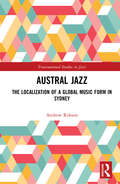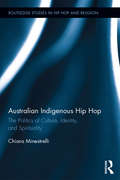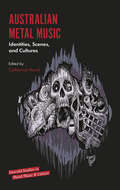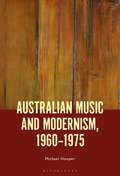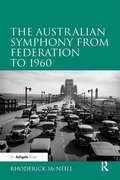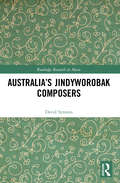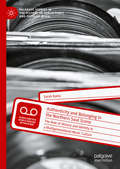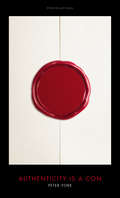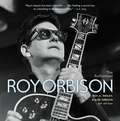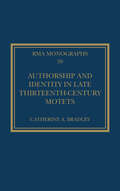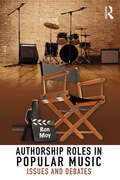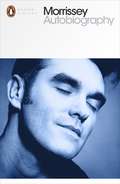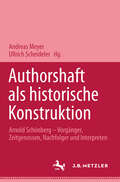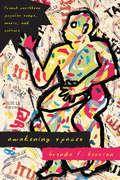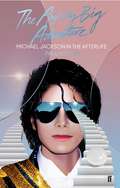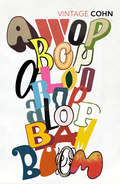- Table View
- List View
Austral Jazz: The Localization of a Global Music Form in Sydney
by Andrew RobsonAustral Jazz: The Localization of a Global Music Form in Sydney proposes a new theoretical framework for understanding local jazz communities as they develop outside the United States, demonstrating such processes in action by applying the framework to a significant period of the history of jazz in Sydney, Australia after 1973. This volume introduces the notion of ‘Austral Jazz,’ coined in order to reset the focus on supranational conceptions of jazz expressions in the southwestern Pacific. It makes the case for Austral Jazz chronologically across six chapters that discuss, interpret and critique major events and seminal recordings, tracing the development of the Austral shift from a pre-Austral period prior to 1973. Austral Jazz presents a fresh approach to understanding the development of jazz communities, and while its focus is on the Sydney scene after 1973, the ‘Austral’ theory can be applied to creative communities globally. A creative shift took place in Sydney in the early 1970s, which led to the flourishing of a new kind of jazz-based expression, one that reflected Australia’s increasingly globalized and multicultural outlook. This study is timely, and it builds on the work of local jazz researchers. Historiographical understandings of global developments in jazz can be understood within a framework of four overarching narratives: The ‘birth and belonging’ narrative; the ‘spread and adaptation’ narrative; the ‘pluralization by localization’ narrative; and the ‘self-fashioning of the already local’ narrative.
Austral Jazz: The Localization of a Global Music Form in Sydney
by Andrew RobsonAustral Jazz: The Localization of a Global Music Form in Sydney proposes a new theoretical framework for understanding local jazz communities as they develop outside the United States, demonstrating such processes in action by applying the framework to a significant period of the history of jazz in Sydney, Australia after 1973. This volume introduces the notion of ‘Austral Jazz,’ coined in order to reset the focus on supranational conceptions of jazz expressions in the southwestern Pacific. It makes the case for Austral Jazz chronologically across six chapters that discuss, interpret and critique major events and seminal recordings, tracing the development of the Austral shift from a pre-Austral period prior to 1973. Austral Jazz presents a fresh approach to understanding the development of jazz communities, and while its focus is on the Sydney scene after 1973, the ‘Austral’ theory can be applied to creative communities globally. A creative shift took place in Sydney in the early 1970s, which led to the flourishing of a new kind of jazz-based expression, one that reflected Australia’s increasingly globalized and multicultural outlook. This study is timely, and it builds on the work of local jazz researchers. Historiographical understandings of global developments in jazz can be understood within a framework of four overarching narratives: The ‘birth and belonging’ narrative; the ‘spread and adaptation’ narrative; the ‘pluralization by localization’ narrative; and the ‘self-fashioning of the already local’ narrative.
Australian Indigenous Hip Hop: The Politics of Culture, Identity, and Spirituality (Routledge Studies in Hip Hop and Religion)
by Chiara MinestrelliThis book investigates the discursive and performative strategies employed by Australian Indigenous rappers to make sense of the world and establish a position of authority over their identity and place in society. Focusing on the aesthetics, the language, and the performativity of Hip Hop, this book pays attention to the life stance, the philosophy, and the spiritual beliefs of Australian Indigenous Hip Hop artists as ‘glocal’ producers and consumers. With Hip Hop as its main point of analysis, the author investigates, interrogates, and challenges categories and preconceived ideas about the critical notions of authenticity, ‘Indigenous’ and dominant values, spiritual practices, and political activism. Maintaining the emphasis on the importance of adopting decolonizing research strategies, the author utilises qualitative and ethnographic methods of data collection, such as semi-structured interviews, informal conversations, participant observation, and fieldwork notes. Collaborators and participants shed light on some of the dynamics underlying their musical decisions and their view within discussions on representations of ‘Indigenous identity and politics’. Looking at the Indigenous rappers’ local and global aspirations, this study shows that, by counteracting hegemonic narratives through their unique stories, Indigenous rappers have utilised Hip Hop as an expressive means to empower themselves and their audiences, entertain, and revive their Elders’ culture in ways that are contextual to the society they live in.
Australian Indigenous Hip Hop: The Politics of Culture, Identity, and Spirituality (Routledge Studies in Hip Hop and Religion)
by Chiara MinestrelliThis book investigates the discursive and performative strategies employed by Australian Indigenous rappers to make sense of the world and establish a position of authority over their identity and place in society. Focusing on the aesthetics, the language, and the performativity of Hip Hop, this book pays attention to the life stance, the philosophy, and the spiritual beliefs of Australian Indigenous Hip Hop artists as ‘glocal’ producers and consumers. With Hip Hop as its main point of analysis, the author investigates, interrogates, and challenges categories and preconceived ideas about the critical notions of authenticity, ‘Indigenous’ and dominant values, spiritual practices, and political activism. Maintaining the emphasis on the importance of adopting decolonizing research strategies, the author utilises qualitative and ethnographic methods of data collection, such as semi-structured interviews, informal conversations, participant observation, and fieldwork notes. Collaborators and participants shed light on some of the dynamics underlying their musical decisions and their view within discussions on representations of ‘Indigenous identity and politics’. Looking at the Indigenous rappers’ local and global aspirations, this study shows that, by counteracting hegemonic narratives through their unique stories, Indigenous rappers have utilised Hip Hop as an expressive means to empower themselves and their audiences, entertain, and revive their Elders’ culture in ways that are contextual to the society they live in.
Australian Metal Music: Identities, Scenes, and Cultures (Emerald Studies in Metal Music and Culture)
by Catherine HoadDefining 'Australian metal' is a challenge for scene members and researchers alike. Australian metal has long been situated in a complex relationship between local and global trends, where the geographic distance between Australia and metal music's seemingly traditional centres in the United States and United Kingdom have meant that metal in Australia has been isolated from international scenes. While numerous metal scenes exist throughout the country, 'Australian metal' itself, as a style, as a sound, and as a signifier, is a term which cannot be easily defined. This book considers the multiple ways in which 'Australianness' has been experienced, imagined, and contested throughout historical periods, within particular subgenres, and across localised metal scenes. In doing so, the collection not only explores what can be meant by Australian metal, but what can be meant by 'Australian' more generally. With chapters from researchers and practitioners across Australia, each chapter maps the distinct ways in which 'Australianness' has been grappled with in the identities, scenes, and cultures of heavy metal in the country. Authors address the question of whether there is anything particularly 'Australian' about Australian metal music, finding that often the 'Australianness' of Australian metal is articulated through wider, mythologised archetypes of national identity. However, this collection also reveals how Australianness can manifest in metal in ways that can challenge stereotypical imaginings of national identity, and assert new modes of being metal 'downungerground'.
Australian Metal Music: Identities, Scenes, and Cultures (Emerald Studies in Metal Music and Culture)
by Catherine HoadDefining 'Australian metal' is a challenge for scene members and researchers alike. Australian metal has long been situated in a complex relationship between local and global trends, where the geographic distance between Australia and metal music's seemingly traditional centres in the United States and United Kingdom have meant that metal in Australia has been isolated from international scenes. While numerous metal scenes exist throughout the country, 'Australian metal' itself, as a style, as a sound, and as a signifier, is a term which cannot be easily defined. This book considers the multiple ways in which 'Australianness' has been experienced, imagined, and contested throughout historical periods, within particular subgenres, and across localised metal scenes. In doing so, the collection not only explores what can be meant by Australian metal, but what can be meant by 'Australian' more generally. With chapters from researchers and practitioners across Australia, each chapter maps the distinct ways in which 'Australianness' has been grappled with in the identities, scenes, and cultures of heavy metal in the country. Authors address the question of whether there is anything particularly 'Australian' about Australian metal music, finding that often the 'Australianness' of Australian metal is articulated through wider, mythologised archetypes of national identity. However, this collection also reveals how Australianness can manifest in metal in ways that can challenge stereotypical imaginings of national identity, and assert new modes of being metal 'downungerground'.
Australian Music and Modernism, 1960-1975
by Michael HooperDrawing on newly available archival material, key works, and correspondence of the era, Australian Music and Modernism defines "Australian Music" as an idea that emerged through the lens of the modernist discourse of the 1960s and 70s. At the same time that the new "Australian Music" was distinctive of the nation, it was also thoroughly connected to practices from Europe and shaped by a new engagement with the music of Southeast Asia. This book examines the intersection of nationalism and modernism at this formative time.During the early stages of "Australian Music" there was disagreement about what the idea itself ought to represent and, indeed, whether the idea ought to apply at all. Michael Hooper considers various perspectives offered by such composers as Peter Sculthorpe, Richard Meale, and Nigel Butterley and analyzes some of the era's significant works to articulate a complex understanding of "Australian Music" at its inception.
Australian Music and Modernism, 1960-1975
by Michael HooperDrawing on newly available archival material, key works, and correspondence of the era, Australian Music and Modernism defines "Australian Music" as an idea that emerged through the lens of the modernist discourse of the 1960s and 70s. At the same time that the new "Australian Music" was distinctive of the nation, it was also thoroughly connected to practices from Europe and shaped by a new engagement with the music of Southeast Asia. This book examines the intersection of nationalism and modernism at this formative time.During the early stages of "Australian Music" there was disagreement about what the idea itself ought to represent and, indeed, whether the idea ought to apply at all. Michael Hooper considers various perspectives offered by such composers as Peter Sculthorpe, Richard Meale, and Nigel Butterley and analyzes some of the era's significant works to articulate a complex understanding of "Australian Music" at its inception.
The Australian Symphony from Federation to 1960
by Rhoderick McNeillThe symphony retained its primacy as the most prestigious large-scale orchestral form throughout the first half of the twentieth century, particularly in Britain, Russia and the United States. Likewise, Australian composers produced a steady stream of symphonies throughout the period from Federation (1901) through to the end of the 1950s. Stylistically, these works ranged from essays in late nineteenth-century romanticism, twentieth-century nationalism, neo-classicism and near-atonality. Australian symphonies were most prolific during the 1950s, with 36 local entries in the 1951 Commonwealth Jubilee Symphony competition. This extensive repertoire was overshadowed by the emergence of a new generation of composers and critics during the 1960s who tended to regard older Australian music as old-fashioned and derivative. The Australian Symphony from Federation to 1960 is the first study of this neglected genre and has four aims: firstly, to show the development of symphonic composition in Australia from Federation to 1960; secondly, to highlight the achievement of the main composers who wrote symphonies; thirdly, to advocate the restoration and revival of this repertory; and, lastly, to take a step towards a recasting of the narrative of Australian concert music from Federation to the present. In particular, symphonies by Marshall-Hall, Hart, Bainton, Hughes, Le Gallienne and Morgan emerge as works of particular note.
The Australian Symphony from Federation to 1960
by Rhoderick McNeillThe symphony retained its primacy as the most prestigious large-scale orchestral form throughout the first half of the twentieth century, particularly in Britain, Russia and the United States. Likewise, Australian composers produced a steady stream of symphonies throughout the period from Federation (1901) through to the end of the 1950s. Stylistically, these works ranged from essays in late nineteenth-century romanticism, twentieth-century nationalism, neo-classicism and near-atonality. Australian symphonies were most prolific during the 1950s, with 36 local entries in the 1951 Commonwealth Jubilee Symphony competition. This extensive repertoire was overshadowed by the emergence of a new generation of composers and critics during the 1960s who tended to regard older Australian music as old-fashioned and derivative. The Australian Symphony from Federation to 1960 is the first study of this neglected genre and has four aims: firstly, to show the development of symphonic composition in Australia from Federation to 1960; secondly, to highlight the achievement of the main composers who wrote symphonies; thirdly, to advocate the restoration and revival of this repertory; and, lastly, to take a step towards a recasting of the narrative of Australian concert music from Federation to the present. In particular, symphonies by Marshall-Hall, Hart, Bainton, Hughes, Le Gallienne and Morgan emerge as works of particular note.
Australia’s Jindyworobak Composers (Routledge Research in Music)
by David SymonsAustralia’s Jindyworobak Composers examines the music of a historically and artistically significant group of Australian composers active during the later post-colonial period (1930s–c. 1960). These composers sought to establish a uniquely Australian identity through the evocation of the country’s landscape and environment, including notably the use of Aboriginal elements or imagery in their music, texts, dramatic scenarios or ‘programmes’. Nevertheless, it must be observed that this word was originally adopted as a manifesto for an Australian literary movement, and was, for the most part, only retrospectively applied by commentators (rather than the composers themselves) to art music that was seen to share similar aesthetic aims. Chapter One demonstrates to what extent a meaningful relationship may or may not be discernible between the artistic tenets of Jindyworobak writers and apparently likeminded composers. In doing so, it establishes the context for a full exploration of the music of Australian composers to whom ‘Jindyworobak’ has come to be popularly applied. The following chapters explore the music of composers writing within the Jindyworobak period itself and, finally, the later twentieth-century afterlife of Jindyworobakism. This will be of particular interest to scholars and researchers of Ethnomusicology, Australian Music and Music History.
Australia’s Jindyworobak Composers (Routledge Research in Music)
by David SymonsAustralia’s Jindyworobak Composers examines the music of a historically and artistically significant group of Australian composers active during the later post-colonial period (1930s–c. 1960). These composers sought to establish a uniquely Australian identity through the evocation of the country’s landscape and environment, including notably the use of Aboriginal elements or imagery in their music, texts, dramatic scenarios or ‘programmes’. Nevertheless, it must be observed that this word was originally adopted as a manifesto for an Australian literary movement, and was, for the most part, only retrospectively applied by commentators (rather than the composers themselves) to art music that was seen to share similar aesthetic aims. Chapter One demonstrates to what extent a meaningful relationship may or may not be discernible between the artistic tenets of Jindyworobak writers and apparently likeminded composers. In doing so, it establishes the context for a full exploration of the music of Australian composers to whom ‘Jindyworobak’ has come to be popularly applied. The following chapters explore the music of composers writing within the Jindyworobak period itself and, finally, the later twentieth-century afterlife of Jindyworobakism. This will be of particular interest to scholars and researchers of Ethnomusicology, Australian Music and Music History.
Authenticity and Belonging in the Northern Soul Scene: The Role of History and Identity in a Multigenerational Music Culture (Palgrave Studies in the History of Subcultures and Popular Music)
by Sarah RaineThis book, which builds on a three-year immersive ethnographic study, argues that what scene participants do and say within the northern soul scene constitutes a claim to belong. For younger members, making claims to belong is problematic in a scene where dominant notions of authenticity held by insiders are rooted in a particular past: the places, people, events, and soundscapes of particular venues during the 1970s. In order to engage with this past, young men and women participate in a range of discursive practices. This book argues that these practices, and the ways they intersect and deviate from dominant notions of authenticity, represent shared and individual negotiations of the 'true soulie'. In doing so, it reveals the rich experiences of the younger generation of this multigenerational music scene, and the ways they establish a claim to belong to a scene first formed before they were born.
Authenticity is a Con: (Provocations) (Provocations Ser.)
by Peter YorkThe idea of authenticity - deliciously vague and as ubiquitous as Starbucks - has hit the spot in almost every sector of 21st-century life. But can we trust the authentic image of Nigel 'man-of-the-people' Farage, Sarah 'hockey mom' Palin or Gwyneth 'inner life' Paltrow? Are punk bands, distressed denim and rustic furniture really as spontaneous as people seem to think? Is bare-brick Shoreditch just one big authenticity scam? From motivational speakers to PR consultants, music entrepreneurs to devoted foodies, bearded hipsters to earnest YouTubers - and, yes, politicians too - 'authentic' has become the buzzword of our age. But, as Peter York has discovered, its meaning has changed and become corrupted: every advertising agency, micro-connoisseur and charlatan going has re-tooled the language of authenticity for our changing market and it is now practically impossible for us to differentiate between authentic and 'authentic'. Drawing on witty anecdotes and analysing various spheres of everyday life, Peter has set out to uncover the truth behind authenticity - the ultimate con of our generation.
The Authorized Roy Orbison
by Alex Orbison Roy Orbison Jr. Wesley OrbisonFor the first time, legendary performer Roy Orbison's story as one of the most beloved rock legends will be revealed through family accounts and records. Roy Orbison is a rock and roll icon almost without peer. He came of age as an artist on the venerable Sun Records label; toured with The Beatles; had massive hits in the 1960s, 1970s, and 1980s; invented the black-clad, sunglasses-wearing image of the rock star; and reinvented the art of songwriting many times over. He is a member of the Rock & Roll and Songwriters Halls of Fame, a recipient of the Musicians Hall of Fame's inaugural Iconic Riff Award, and the winner of multiple GRAMMY® awards. He is known the world over for hits like "Blue Bayou," "You Got It," and "Oh, Pretty Woman" and was a member of the band that inspired the term "supergroup"-the Traveling Wilburys, with Bob Dylan, George Harrison, Jeff Lynne, and Tom Petty. Despite these and countless other accolades, the story of Roy Orbison's life is virtually unknown to his millions of fans around the world. Now, for the first time ever, the Orbison Estate, headed by Roy's sons, Wesley, Roy Jr., and Alex Orbison, has set out to set the record straight. The Authorized Roy Orbison tells the epic tale of a West Texas boy, drawn to the guitar at age six, whose monumental global career successes were matched at nearly every turn by extraordinary personal tragedies, including the loss of his first wife in a motorcycle accident and his two oldest sons in a fire. It's a story of the intense highs and severe lows that make up the mountain range of Roy Orbison's career; one that touched four decades and ended abruptly at perhaps its highest peak, when he passed away at the age of fifty-two on December 6, 1988. Filled with hundreds of photographs, many never before seen, gathered from across the globe and uncovered from deep within the Orbison Vault, The Authorized Roy Orbison shows Roy Orbison as a young child and follows him all the way through to the peak of his stardom and up to his tragic end. Wesley, Roy Jr., and Alex Orbison-Roy's Boys-have left no stone unturned in order to illustrate the people, places, things, and events that forged their father, the man behind those famous sunglasses.
The Authorized Roy Orbison: The Authorized Biography
by Alex Orbison Roy Orbison Wesley OrbisonFor the first time, legendary performer Roy Orbison's story as one of the most beloved rock legends will be revealed through family accounts and records. p.p1 {margin: 0.0px 0.0px 0.0px 0.0px; text-indent: 36.0px; font: 12.0px Geneva} p.p2 {margin: 0.0px 0.0px 0.0px 0.0px; font: 12.0px Geneva} span.Apple-tab-span {white-space:pre} Roy Orbison is a rock and roll icon almost without peer. He came of age as an artist on the venerable Sun Records label; toured with The Beatles; had massive hits in the 1960s, 1970s, and 1980s; invented the black-clad, sunglasses-wearing image of the rock star; and reinvented the art of songwriting many times over. He is a member of the Rock & Roll and Songwriters Halls of Fame, a recipient of the Musicians Hall of Fame's inaugural Iconic Riff Award, and the winner of multiple GRAMMY® awards. He is known the world over for hits like "Blue Bayou," "You Got It," and "Oh, Pretty Woman" and was a member of the band that inspired the term "supergroup"-the Traveling Wilburys, with Bob Dylan, George Harrison, Jeff Lynne, and Tom Petty. Despite these and countless other accolades, the story of Roy Orbison's life is virtually unknown to his millions of fans around the world. Now, for the first time ever, the Orbison Estate, headed by Roy's sons, Wesley, Roy Jr., and Alex Orbison, has set out to set the record straight. The Authorized Roy Orbison tells the epic tale of a West Texas boy, drawn to the guitar at age six, whose monumental global career successes were matched at nearly every turn by extraordinary personal tragedies, including the loss of his first wife in a motorcycle accident and his two oldest sons in a fire. It's a story of the intense highs and severe lows that make up the mountain range of Roy Orbison's career; one that touched four decades and ended abruptly at perhaps its highest peak, when he passed away at the age of fifty-two on December 6, 1988. Filled with hundreds of photographs, many never before seen, gathered from across the globe and uncovered from deep within the Orbison Vault, The Authorized Roy Orbison shows Roy Orbison as a young child and follows him all the way through to the peak of his stardom and up to his tragic end. Wesley, Roy Jr., and Alex Orbison-Roy's Boys-have left no stone unturned in order to illustrate the people, places, things, and events that forged their father, the man behind those famous sunglasses.
Authorship and Identity in Late Thirteenth-Century Motets (Royal Musical Association Monographs)
by Catherine A. BradleyQuestions of authorship are central to the late thirteenth-century motet repertoire represented by the seventh section or fascicle of the Montpellier Codex (Montpellier, Bibliothèque interuniversitaire, Section de médecine, H. 196, hereafter Mo). Mo does not explicitly attribute any of its compositions, but theoretical sources name Petrus de Cruce as the composer of the two motets that open fascicle 7, and three later motets in this fascicle are elsewhere ascribed to Adam de la Halle. This monograph reveals a musical and textual quotation of Adam’s Aucun se sont loe incipit at the outset of Petrus’s Aucun ont trouve triplum, and it explores various invocations of Adam and Petrus – their works and techniques – within further anonymous compositions. Authorship is additionally considered from the perspective of two new types of motets especially prevalent in fascicle 7: motets that name musicians, as well as those based on vernacular song or instrumental melodies, some of which are identified by the names of their creators. This book offers new insights into the musical, poetic, and curatorial reception of thirteenth-century composers’ works in their own time. It uncovers, beneath the surface of an anonymous motet book, unsuspected interactions between authors and traces of compositional identities.
Authorship and Identity in Late Thirteenth-Century Motets (Royal Musical Association Monographs)
by Catherine A. BradleyQuestions of authorship are central to the late thirteenth-century motet repertoire represented by the seventh section or fascicle of the Montpellier Codex (Montpellier, Bibliothèque interuniversitaire, Section de médecine, H. 196, hereafter Mo). Mo does not explicitly attribute any of its compositions, but theoretical sources name Petrus de Cruce as the composer of the two motets that open fascicle 7, and three later motets in this fascicle are elsewhere ascribed to Adam de la Halle. This monograph reveals a musical and textual quotation of Adam’s Aucun se sont loe incipit at the outset of Petrus’s Aucun ont trouve triplum, and it explores various invocations of Adam and Petrus – their works and techniques – within further anonymous compositions. Authorship is additionally considered from the perspective of two new types of motets especially prevalent in fascicle 7: motets that name musicians, as well as those based on vernacular song or instrumental melodies, some of which are identified by the names of their creators. This book offers new insights into the musical, poetic, and curatorial reception of thirteenth-century composers’ works in their own time. It uncovers, beneath the surface of an anonymous motet book, unsuspected interactions between authors and traces of compositional identities.
Authorship Roles in Popular Music: Issues and Debates
by Ron MoyAuthorship Roles in Popular Music applies the critical concept of auteur theory to popular music via different aspects of production and creativity. Through critical analysis of the music itself, this book contextualizes key concepts of authorship relating to gender, race, technology, originality, uniqueness, and genius and raises important questions about the cultural constructions of authenticity, value, class, nationality, and genre. Using a range of case studies as examples, it visits areas as diverse as studio production, composition, DJing, collaboration, performance and audience. This book is an essential introduction to the critical issues and debates surrounding authorship in popular music. It is an ideal resource for students, researchers, and scholars in popular musicology and cultural studies.
Authorship Roles in Popular Music: Issues and Debates
by Ron MoyAuthorship Roles in Popular Music applies the critical concept of auteur theory to popular music via different aspects of production and creativity. Through critical analysis of the music itself, this book contextualizes key concepts of authorship relating to gender, race, technology, originality, uniqueness, and genius and raises important questions about the cultural constructions of authenticity, value, class, nationality, and genre. Using a range of case studies as examples, it visits areas as diverse as studio production, composition, DJing, collaboration, performance and audience. This book is an essential introduction to the critical issues and debates surrounding authorship in popular music. It is an ideal resource for students, researchers, and scholars in popular musicology and cultural studies.
Autobiography: The Autobiography To End All Theatrical Biographies (Penguin Modern Classics Series)
by MorrisseySteven Patrick Morrissey was born in Manchester on May 22nd 1959. Singer-songwriter and co-founder of the Smiths (1982-1987), Morrissey has been a solo artist for twenty-six years, during which time he has had three number 1 albums in England in three different decades.Achieving eleven Top 10 albums (plus nine with the Smiths), his songs have been recorded by David Bowie, Nancy Sinatra, Marianne Faithfull, Chrissie Hynde, Thelma Houston, My Chemical Romance and Christy Moore, amongst others. An animal protectionist, in 2006 Morrissey was voted the second greatest living British icon by viewers of the BBC, losing out to Sir David Attenborough. In 2007 Morrissey was voted the greatest northern male, past or present, in a nationwide newspaper poll. In 2012, Morrissey was awarded the Keys to the City of Tel-Aviv. It has been said 'Most pop stars have to be dead before they reach the iconic status that Morrissey has reached in his lifetime.'Autobiography covers Morrissey's life from his birth until the present day.'The Best Music Biog Ever ... In the world of rock autobiographies, Morrissey's is nigh-on perfect'NME
Autorschaft als historische Konstruktion: Arnold Schönberg - Vorgänger, Zeitgenossen, Nachfolger und Interpreten
by Andreas Meyer Ullrich ScheidelerSchönberg zwischen Vergangenheit und Zukunft - die Beiträge des zu Schönbergs 50. Todestag erscheinenden Bandes vermessen den historischen Ort seines Werks von den "klassischen" Ahnen wie Bach über die Zeitgenossen Brahms und Mahler bis zur versteckten Huldigung bei Carter und Rihm.
Awakening Spaces: French Caribbean Popular Songs, Music, and Culture (Chicago Studies in Ethnomusicology)
by Brenda F. BerrianThe fast-paced zouk of Kassav', the romantic biguine of Malavoi, the jazz of Fal Frett, the ballads of Mona, and reggae of Kali and Pôglo are all part of the burgeoning popular music scene in the French Caribbean. In this lively book, Brenda F. Berrian chronicles the rise of this music, which has captivated the minds and bodies of the Francophone world and elsewhere. Based on personal interviews and discussions of song texts, Berrian shows how these musicians express their feelings about current and past events, about themselves, their islands, and the French. Through their lyrical themes, these songs create metaphorical "spaces" that evoke narratives of desire, exile, subversion, and Creole identity and experiences. Berrian opens up these spaces to reveal how the artists not only engage their listeners and effect social change, but also empower and identify themselves. She also explores the music as it relates to the art of drumming, and to genres such as African American and Latin jazz and reggae. With Awakening Spaces, Berrian adds fresh insight into the historical struggles and arts of the French Caribbean.
The Awfully Big Adventure: Michael Jackson in the Afterlife
by Paul MorleyMichael Jackson died on June 25 2009 in Los Angeles, from of acute propofol and benzodiazepine intoxication (according to Wikipedia). The one-time King of Pop was preparing for one last assault on the mainstream with a proposed 50 night run of shows at the 02 (thereby trumping his arch-rival, Prince, who had just concluded his legendary 21 Nights). His exhaustion, paranoia and general ill-heath were an open secret. He had lived many lives and inhabited many bodies; PT Barnum, Fred Astaire, and Peter Pan in one mortal coil. His death was mourned by hundreds of millions of fans but it was almost as if he had been dead for some time already. And in his death, in vivid technicolor, we relived the dreams, nightmares, fantasies, and perversions that we had all projected on to him for four decades. Paul Morley's short biographical portrait of Michael Jackson looks at how we turned the most outrageous child star talent of the late 20th century into a monster; how his decline soundtracked the end of Pop and the end of American Imperialism; how his once staggeringly modern and funky music became secondary to the dysfunctional freak show of watching a vulnerable man literally disintegrate. Tender, erudite, and provocative, Morley's monograph documents a tragedy that is so Shakespearean in scale that it obscures the legacy of the last of the great Song and Dance Men.
Awopbopaloobop Alopbamboom: Pop From The Beginning
by Nik CohnNik Cohn began to write this book in the late 1960s with a simple purpose: to catch the feel, the pulse of Rock. Nobody had written a serious book on the subject before, and there were no reference books or research to refer to. The result is an unruly, thrilling and definitive history of an era, from Bill Haley to Jimi Hendrix, full of guts, flash, energy and speed. In vividly describing the music and cutting through the hype, Nik Cohn engendered and perfected a new form: rock criticism.
